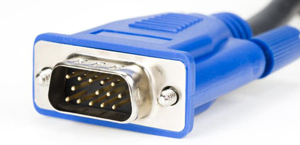
Your monitor cable typically looks like this
If you are connecting a (secondary) monitor to a laptop, you MAY need an adapter. Here is a guide:
Most monitors come with a standard VGA connector/cable. See the image to the right.
The cable is typically blue and has three rows of pins.
PC’s or Older Macs
 If you have a PC or a (very) old Mac, then chances are it has a matching port.
If you have a PC or a (very) old Mac, then chances are it has a matching port.
If you have a port like the one on the right on your computer, you do NOT need an adapter.
Older MacBook Air’s or Pro’s
 Most of the SDP Apple laptops in circulation are MacBook Airs or Pros that have a “Mini DisplayPort” connection.
Most of the SDP Apple laptops in circulation are MacBook Airs or Pros that have a “Mini DisplayPort” connection.
If you have a port like the one on the right, then you will need a “MINI DISPLAY-PORT adapter”. This is the same as what you would use to connect your laptop to a projector or a smart-board.
If you do not have one, you can request one when you fill out your monitor application.
Newer MacBooks or Chromebooks
 If you received a new MacBook recently (or if you use a Chromebook), these will typically have a newer type of USB-C connector.
If you received a new MacBook recently (or if you use a Chromebook), these will typically have a newer type of USB-C connector.
If you (only) have a port like the one on the right, then you will need a “USB-C adapter”.
If you do not have one, you can request one when you fill out your monitor application.
Other Laptops
 If we/PCF gave you a laptop or you are using your own, it may have an HDMI connector.
If we/PCF gave you a laptop or you are using your own, it may have an HDMI connector.
If your computer only has an HDMI connector like the one on the right, then you will need an “HDMI adapter”.
If you do not have one, you can request one when you fill out your monitor application.
